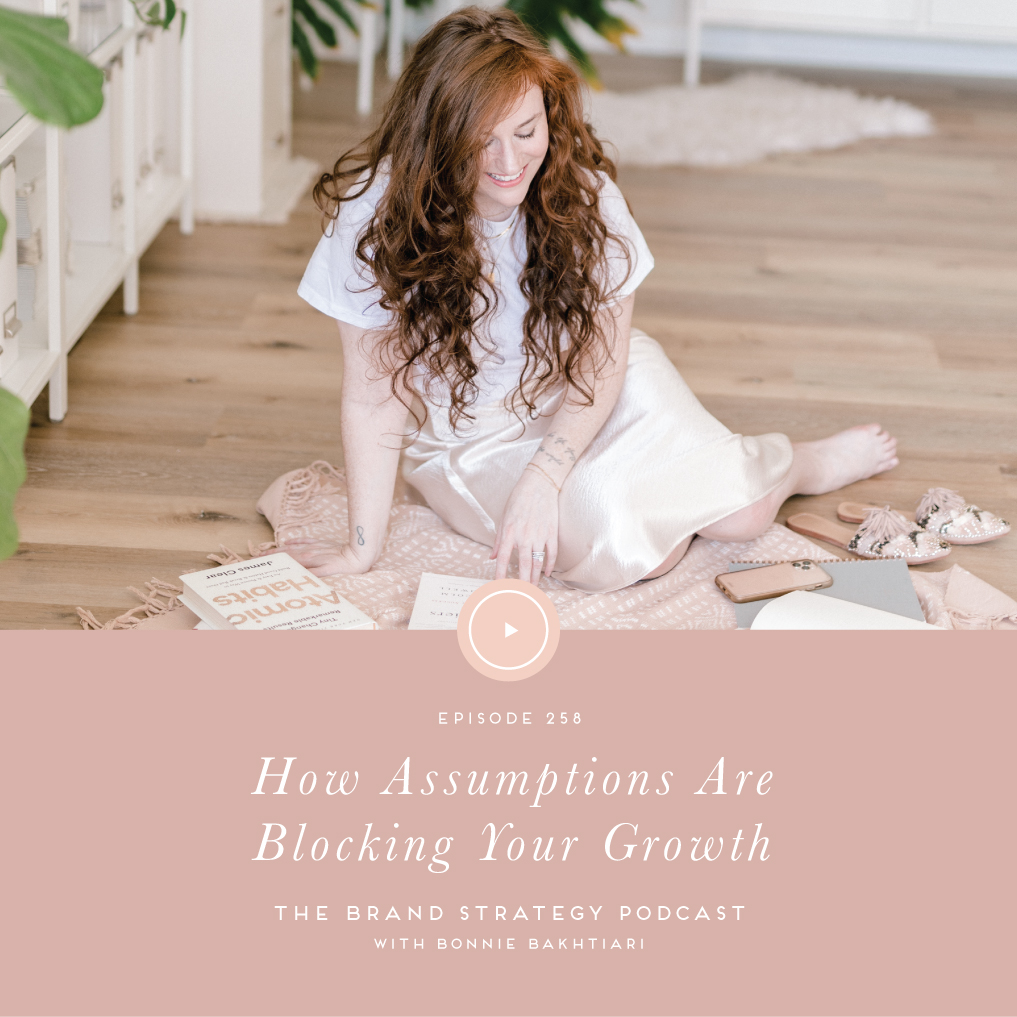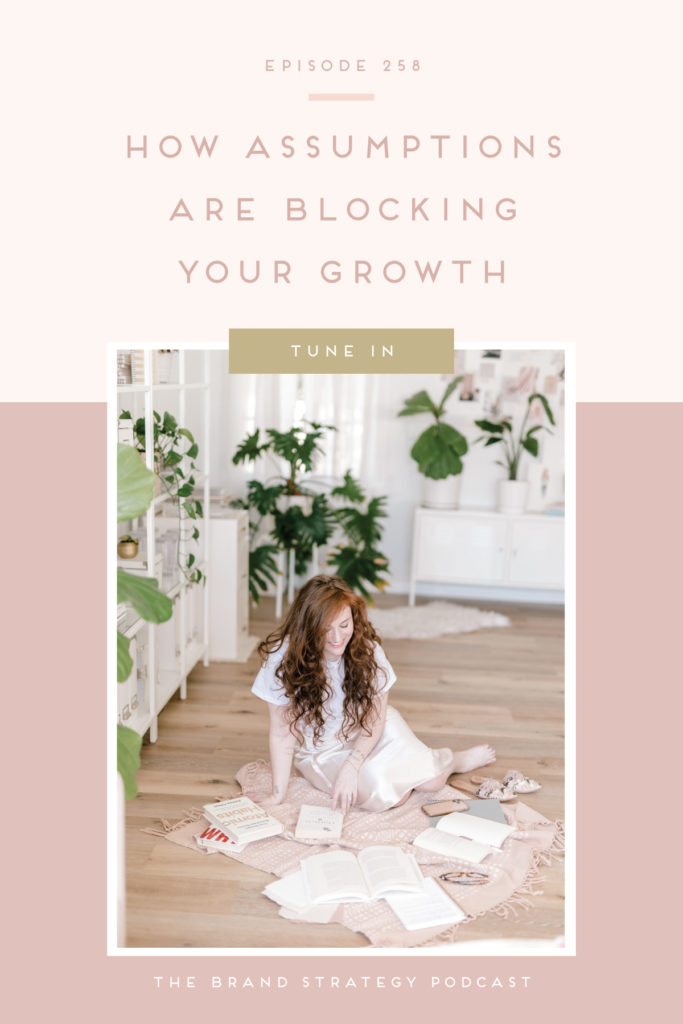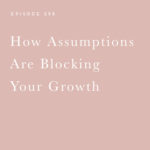Podcast: Play in new window | Download
Subscribe: Google Podcasts | Spotify | RSS

Are you terrible about mmaking assumptions in your business about potential or existing clients? We’ve all been there, but have you considered how those assumptions are blocking your growth? In today’s episode, I’m sharing three assumptions you may be making in your business that are holding you back, along with a mindset shift to help you overcome the anxiety that comes with those assumptions!
If today’s episode resonates with you and you want to show support for the show, here’s an easy way to do so: Buy Me A Coffee!
How Assumptions Are Blocking Your Growth
The one-on-one relationships you have with your clients are so important to the growth of your business and the impact you have on those your serve. One of the most powerful approaches to deepening the impact that you can have with the relationships in your business is to remove assumptions. The assumptions you have in regards to your clients and potential clients can block your growth and limit you from serving well.
Assumptions Around Client Budgets
When it’s time to connect with a new lead, we often tell ourselves a “story” about how much money our clients are willing to spend. We’ll easily walk through what we do, listen to their questions and answer with confidence, yet when it comes time for pricing, it’s easy to think that a potential client can’t afford you.
Spoiler alert: You don’t know how much they can afford. By telling ourselves these stories, we’re preventing ourselves from showing up as your best self for your clients. Of course there will be times when you’re out of someone’s budget—but assuming it’s every single time will limit you from serving them well.
Assumptions on Experience, Business Types, & Readiness
Similarly to budgets, sometimes as business owners who have to be salespeople, we make assumptions on potential clients based on their business—whether it’s a new business, a small audience, or a lack of experience.
We tell ourselves a similar story in that they’re not ready to work with us—despite their own needs, desires, and journey. It’s so easy to dismiss someone based on these assumptions, but you never know when a client has set aside the budget, researched your services, or simply admired your work.
Personal Relationship
Now, we’ve talked about potential clients, but what about existing relationships with clients? Have you ever felt like a client ghosted you for a minute? It’s so easy to put a personal assumptions on lack of communication in a working relationship. Did you do something to make them go silent? You may assume that a client is upset with you for whatever reason, yet they could simply be struggling with an external factor that has nothing to do with you.
Assumptions like these are damaging to relationships: both personal and business. You’re giving yourself anxiety for no reason.
Accountability & Responsibility
It took me a long time to realize that I’m only responsible and accountable for my own actions and how I show up. You’re not responsible for the actions of others, how they feel about you, etc. Of course you care, but you do not have to carry the burden of these assumptions.
Shift your perspective—acknowledge what is within your control. This includes your actions and your impact on others. Think about how you can focus on showing up, being a responsible human, and how it will impact the relationships around you.
When you choose to focus on the thing in your control, your life and business will change. This is your reminder show up, hear your client, see your client, and get out of your own way in order to show up and serve at your most powerful level while leaving a lasting and positive impact on those around you.
SUPPORT THE SHOW
FOLLOW ALONG
LIKE THE SHOW?
IN ORDER TO PROVIDE CONTENT YOU LOVE I WANT TO HEAR FROM YOU! SUBSCRIBE TO THE BRAND STRATEGY PODCAST AND LEAVE A 5-STAR REVIEW HERE. THE MORE REVIEWS, THE MORE I’M ABLE TO PROVIDE THIS FREE-ACTIONABLE CONTENT!

Review the Transcript:
Hi, friend, and welcome to the Brand Strategy Podcast, a show created to equip you with the inspiration, encouragement, and clarity you need to build a brand of your dreams. I’m your host, Bonnie bti, brand designer, strategist, and founder of the Alum Retreat from sustainable strategy to heartfelt Encouragement. Each episode is designed to equip you with the tools you need to chase after your dreams because you deserve a brand that empowers you to do what you love, connects with your dream clients, and offers a deep sense of fulfillment along the way. So grab a cup of coffee and join me on this journey, won’t you?
Hey, friend. Welcome back to the Brand Strategy Podcast. Today, I am excited to bring you a short and sweet episode all about one of my most powerful approaches to deepening the impact that you can have with the relationships in your business. So what I mean by that is this is a action, a mindset, a practice you can implement that enables you to show up differently for yourself, for your clients, for your colleagues, for your biz bestie, or your industry friends. I mean, oh my gosh, this is even something that you can implement in your personal relationships. Oh, your partner, your kids, if you have them, your family members, your friends, right? The people in your community. And this is deceptively simple. The more that I really focus on some of the transformative thoughts or some of the powerful actions that we can take in business that really help us to pursue what success means to us, the more I am just like constantly blown away by how simple a lot of these actions are, or a lot of these concepts.
And it’s not that we’re not aware or we’re not paying attention, it’s often at least I can speak from my own experience. It’s often that I’m over complicating things and I’m making it harder than it needs to be. And so when I stop tuning into all that drama in my head and I start looking at the actual facts and the data, I find that the solution I’ve been seeking is very simple. And that’s a beautiful thing because simple means it’s accessible, it means that I can implement it, it means that I have a higher chance of actually doing the thing and not messing it up in some cases. But today, I want to encourage you to think about the way that you’re approaching conversations with people. So for the sake of this episode, let’s kind of take it from a standpoint of you are connecting with a potential client.
So you’re chatting with a lead and they’re interested in your services. Uh, whether you are a graphic designer, brand designer, web designer, uh, a photographer, a wedding or event planner, you are a calligrapher, a floral designer, a coach, uh, you know, a personal trainer like I could keep going regardless of what your industry actually is, if you’re providing a specific service to your ideal clients or your ideal customers, usually there’s a conversation that’s happening right around the actual sale of your services. So for argument’s sake, let’s say that you are a high ticket service provider. And so in order for people to hire you and work with you, they need to hop on a discovery call or a sales call. And during that conversation, y’all are talking about their goals, their vision, how they’re defining success within the context of this project. You’re walking them through your method and helping to map out exactly how your process that you’ve created is gonna be transformative or valuable to them.
And then usually towards the end of the conversation, we start talking about budget, right? We start talking about what’s the investment or what’s the budget that you would like to honor within this project? Or, you know, those kinds of conversations. And here’s where we can really be diligent and thinking differently about this part of the conversation. Normally, when most service providers start having this conversation around money with a potential client, they start telling themselves subconsciously a story about how much money or how many resources this lead has access to. What this can look like is you’re talking to a potential design client and they’re telling you all about all of the incredible assets they wanna create and their vision for their brand. And then we get to the question about budget, and you start telling yourself a story of, oh, based on what they shared with me so far, I don’t know if they have enough to, you know, enough resources to sign on to work with me right now.
You start telling yourself a story of, oh, I’m too expensive. What are they gonna think? Should I bump a couple hundred dollars off my price? So I, you know, seem like less intimidating, or I seem like more of a viable option? We start telling ourselves all of these stories about how we are too much. And those stories often hinge on this thought that what this potential client has is not enough. And where I see people getting stuck with this is they are effectively putting themselves in the pockets of their lead, and they don’t have the information to back that up. So think of it this way, if you’re talking to a potential client and you’re telling yourself this story about what they can and can’t afford, you don’t actually know that, do you? Because unless you’re asking for screenshots of their bank account, unless you are getting a full financial statement in detail prior to having that conversation with this person, you do not have the available information to make that judgment.
So what you’re doing is you were telling yourself a story about what their situation looks like, about what they can afford and what they can’t afford. But what we need to remember here is that we don’t know that for sure. So when we focus on telling ourselves those kinds of stories, we’re actually damaging our ability to show up and serve that person at our highest level. And I’m not talking highest in terms of your, your highest package or your highest price point. I’m talking your highest energy, your best self, your most present self, right? Because when we start telling ourselves a story about how we’re chatting with a lead who can’t afford us, we then start to deflate the momentum that we built during that conversation and we start to tell ourselves, you know, ugh, this isn’t gonna work out. And that’s a bummer cuz I’m wasting my time and I’m wasting their time.
And you know, I like don’t, I really would like to book this client, but I don’t feel good about discounting my prices, but I don’t want them to be mad at me because we spent this like 30 minutes having this conversation and it’s not fruitful. You know, like the the narrative goes on and on and on. But it’s a narrative that’s built on a lack of information. And so we are constantly making these decisions and making these moves based on information that’s like literally just made up, like our brains just completely imagined that. And like another example of what this can look like, uh, recently I was having a conversation with one of the designers inside the brand strategy school, which is my signature program for designers. And they were saying, Hey, I’m chatting with this nonprofit and they wanna hire me for, you know, like my highest level of service, like my biggest package, but they’re a nonprofit.
I what, you know, how do I price this? Do I, do I, you know, discount my pricing? Do I give them like a special deal or anything like that? And it was so cool because not only were folks weighing in with their own experiences, because this was happening inside our private community, but also we got to have a conversation about the assumptions that this designer was making about this nonprofit. Because yes, it’s true that some nonprofits don’t have a big operating budget, and so they don’t have a lot of resources available to invest in things like brand identity and website design. But we also have to remember that nonprofits have access to things like grants, external funding. Some nonprofits have massive, massive operating budgets. Just because they’re a nonprofit does not mean that they have $0 to work with you. Now, the, as as with everything in life, this is not a blanket statement.
I’m not saying that all the, the nonprofits out there are like rolling in in money because that’s simply not true. But what I am saying is that we, when we tell ourselves this story about how nonprofits don’t have the budget to hire me, an expensive designer, we are telling ourselves that this is doomed from the start. We’re telling ourselves that like, this isn’t gonna, this isn’t gonna work out. And in order for it to work out, we then need to compromise on our services or on our deliverables, and we’re not creating the best solution for ourselves or for that potential client. But when we actually look at what we’re doing, which is in that case, we are putting ourselves, we are like all up in this nonprofit’s like wallet, basically. We’re all up in their pockets, we’re all up in their bank account, we are, you know, going wild with the assumptions in this case.
And so what’s really great about that though is recognizing that that’s something you can change. So with this designer inside the brand strategy school, the conversation that we had was, Hey, instead of getting so focused on this, this train of thought that’s built on assumptions, let’s open up all of the options. And when we open up the options, we acknowledge that, right? There’s grants, there’s funding, uh, we don’t know what this nonprofit’s operating budget is. And so you don’t need to go in and discount your services right off the bat unless you would like to, if that’s your, if you want to focus on, on building more philanthropy into the work that you do, you absolutely can give them a discount. But you get to decide that from a place of generosity, not from a place of fear. And the same concept applies to when you’re working with clients, right?
If you are chatting with someone and you are telling yourself all of this nonsense based on assumptions that you’ve made of what they can and can’t afford, you don’t know that for sure. There have been times in my career where I’ve been chatting with, with startup businesses, like, like they are coming to me, they have no presence, they have no clients yet they have not worked with anybody for free or paid like they, all they have is like an idea , and the determination to bring that idea to life. And you know, the story that I could have told myself was, this is a startup. I usually work with established businesses, they’re not gonna have the budget for me. And lo and behold, this startup showed up and invested wild amounts of money, like thousands and thousands and thousands of dollars in working with me because they had the resources and they saw the value and the work that I do.
And they decided that from day one, they wanted that kind of strategic brand that was gonna empower them to experience success. So with that being said, right, if I had told myself all of this, all of this about, oh, you know, they haven’t worked with a client yet, they probably don’t have, you know, the, their business isn’t generating revenue, right? They don’t have the revenue , they don’t have the profit to invest in hiring me as their brand strategist and their designer. But you know what, in this case, this client had savings set aside that they had earmarked specifically to bankroll their new business. And we hear stories like this all the time where people are choosing to invest resources that again, we don’t know they have because we’re not privy to that information, nor should we be in most cases. And so if we get out of our own way and we focus on, instead of telling ourselves what we believe is happening with that lead or that potential client and their life, their finances, their, their time, their energy, whatever resources they have access to, we need to stop doing that.
And we need to instead focus on what do I hear this potential client saying to me? What are their goals? What do they need help with? Where are they looking for value or for the transformation that I know my services can provide to them? And then we look at you and how you do your best work and what you need to show up in the best way possible. And we then make, make the choice to take action from that place. And we show up and say, I hear you and I see you and I know that this is where you are and my services can meet you in that space. And together here’s the kind of growth that we can experience. Or here’s the kind of transformation that we can create for you and for your business. And when we get out of our own way and we stop telling ourselves all kinds of stories, then we are able to show up and serve at our highest level from our most powerful place because we are asking for everything that we need in order to do our best work and to help that client in the way that we are uniquely equipped to help them, to serve them, to work with them.
And like I said earlier, this can apply not only to your business relationships, but also your personal relationships. I mean, think about it this way, if you were working with a, a client and you start telling yourself a story about this is why they’re not responding to me, this is why their email replies are always so delayed, you know, they must not like the work that we’re doing, or they must be unhappy with me, or, you know, whatever. And then your client comes back to you and says, Hey, sorry for the radio silence. I’ve had some personal stuff going on with my family and I haven’t been available. Let’s dive back in, right? If we would have just looked at the facts and what we knew and what we knew was your client who’s normally responsive, isn’t so responsive right now, something must be going on, we don’t know what, but we are going to do what’s within our control.
We’re gonna follow up a couple times and we’re going to be patient because we understand that life happens and we don’t have all the information instead, right? If you are telling yourself this, this, you know, you’re making it personal, really, and I’ve done this before where I, I tell myself, oh, my client who’s, you know, normally is so quick to respond to me, all of a sudden they kind of like ghost me. It’s gotta be something that I said, it’s gotta be something that I did they’re unhappy with, like the design work that I did or something like that. And I’m, I’m causing myself too, on a very, very, very, very low level, I’m causing myself suffering. Essentially, I’m causing myself this anxiety, this stress, this, you know, like all these negative emotions. And I could have avoided that if I just focused on looking at the facts.
And the facts were, girl, you don’t know that. You don’t have that information. You don’t know what’s going on in their life. If they haven’t told you , then you don’t know it. And so with that being said, you know, this can, this can be something, a practice really, it’s like, it’s a form of accountability and responsibility really is what it is. I I look back on conversations that I’ve had earlier, um, this year with my therapist. And a big theme that we talk about in different capacities is this concept of responsibility and this concept of, of like radical accountability. And it’s this concept that tells us that we can only control what’s within our control. And that would be our actions, our impact, our emotions, the way that like we take action in the way that we show up. We’re responsible for ourselves. We are not responsible for the reactions of other people.
We are not responsible for the emotions of other people. We are not responsible for what they think of us, or we’re not responsible for what they do or anything like that because we are only responsible for ourselves. And so if something is happening outside of you by nature, that is not yours, that is not yours to carry. Now this is not to say that we don’t care , that we like become these like very callous, unfeeling humans. Absolutely not. This is to say that in our relationships, in conversations with people that we work with, with our team members, with our clients, with contractors, with industry friends, with you know, partners, personal friends, family members, people in your community, when you’re connecting with them, we have to shift our perspective. And instead of focusing on trying to manage their expectations or trying to hedge, you know, our actions so that we don’t make them feel a certain way, we have to acknowledge that what is within your control is how you show up, how you act, how you communicate with people, how you treat people, and you’re responsible for that.
And of course, we’re human and so we’re not always gonna get this right. And there are times when we have good intentions, yet the impact that we have is harmful to some, and we need to take responsibility and make that right and seek to create restitution when at all possible. But with all of that in mind, it’s a matter of thinking about how can you focus on showing up and being the incredibly radically responsible human that you can be for yourself and to yourself. And how then can that really just like bleed out into all the relationships around you? So with all that being said, friend, what I’m, what I’m trying to communicate here is that when you choose to focus on what you know to be true, when you choose to focus on what is within your control, when you focus on the responsibility that you can accept and that you can own for what is within your control, life begins to change.
Business begins to change because instead of experiencing the stress, the anxiety, the struggle, the drama of telling ourselves, you know, uh, a kind of like so proper basically about, uh, whether a person can afford you or whether a person is ghosting you or really anything, anything we find that we free ourselves from the stress, the anxiety, the struggle, the confusion, the overthinking that we would be experiencing if we were really going down that road. And it’s, it’s beautiful. It’s incredibly powerful. This is something that I even have seen myself, like really start to practice more and more in all aspects of my life. And it’s given me so much more freedom to show up in the way that I want to in conversations with people, because all that I’m responsible for is managing my part of the conversation and managing my part of the relationship.
And I don’t have to read the other person’s mind and I don’t have to try to, you know, like figure out how to act and how to, you know, communicate and how to do all these things based on all these alternate scenarios that I’ve literally just made up in my head. And if you like me, are a person who experiences anxiety. That can be really powerful and that can be really beautiful because it frees you from having to focus on not only managing yourself, but then managing how everyone in the world around you is is like, um, you know, interacting with you. And instead it, it puts it back into perspective of knowing that like you are only responsible for yourself and for the way that you move through the world. And if we look at that, then of course it wouldn’t make sense for you to be all up in your potential client’s pockets, right?
It would not make any sense for you to be telling yourself this story about whether they can afford you or they can’t. It would only make sense for you to show up to that conversation, to actively listen to your potential client, to make them feel seen, heard and valued, to respect them as a human and to present them with a solution that will actually serve them well. Whether that means working with you or working with someone else. And we’re not gonna be making assumptions based on what we think someone’s financial situation is or where we think they are in their business. We’re going to trust that at least in this context, right, in this professional context, we’re gonna trust that the people we’re speaking with are adults and they’re able to communicate with us what they need and what they want. And we believe them when they share that with us.
And that then helps us to point them towards the solution, the level of service, the product, or maybe even the industry referral who’s going to be exactly what they’re looking for in this season. So I hope that this is helpful. I hope that this helps to kind of put things into perspective a little bit. I know that we covered a couple of different topics today. You know, not only like the, the thought of stop making assumptions in business, but also we’ve talked about this concept of responsibility and what that looks like in your relationships, whether they’re personal or professional. And I hope that this is something that just gives you some food for thought. I’m, again, speaking from my own personal experience, from conversations that I’ve had with my incredible students since inside had the brand strategy school with, you know, conversations that I’ve had with lots of people over the years.
And this is something that I believe more and more people are becoming aware of and they, whether consciously or subconsciously, and they’re choosing to take action from that space. But it’s something that I wanted to share here, because this is going to help you get out of your own way when you are working with people in whatever capacity, whether that is, you know, you and a team member, you and your va, you and a potential client, you and a current client, right? And then all the different implications that this can have in your personal life with your friends, your family, your partner, you know, the people in your community, your children, all sorts of relationships. And that can be, that can be powerful, that can be life changing, that can create this ripple effect that originates with you, but then goes out into everyone around you and it impacts them in a way where you’re modeling what it means to show up at your highest level with the understanding of the impact you’re able to have, the, the accountability you’re able to hold for yourself and for others, the compassionate way that you are connecting with humans around you.
So thanks for tuning into today’s episode. I hope this again is giving you some good things to consider. And if this sparked a thought and you’d like to chat with me more, my dms are always open. So you can always reach out to me at Bonnie Joy Marie on Instagram and let me know. And really anything that you would like to talk through and process more about this in the show notes, I’ll link to some resources around this topic a little bit more. Especially that concept of radical responsibility If in case you kind of wanna go down that rabbit trail a little bit and learn more for yourself. But as always, I’m grateful for you being a part of this community and I’m cheering you on from Waco.
Thank you so much for joining me today, friend. Before you go, I would be so grateful to receive your feedback on the brand strategy podcast. If you enjoyed this episode or the podcast in general has helped you grow your brand, I’d really appreciate it if you left us a review in iTunes. Your positive reviews enable the brand strategy podcast to continue to grow and reach like-minded creatives just like you. Thank you for all your support and encouragement as together we pursue building brands with purpose and intention. Until next time, I’m cheering you on from Waco.






leave a comment